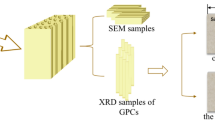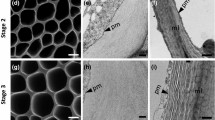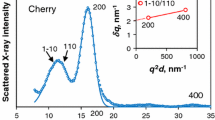Abstract.
Atomic force microscopy (AFM) was used to image celery (Apium graveolens L.) parenchyma cell walls in situ. Cellulose microfibrils could clearly be distinguished in topographic images of the cell wall. The microfibrils of the hydrated walls appeared smaller, more uniformly distributed, and less enmeshed than those of dried peels. In material that was kept hydrated at all times and imaged under water, the microfibril diameter was mainly in the range 6–25 nm. The cellulose microfibril diameters were highly dependent on the water content of the specimen. As the water content was decreased, by mixing ethanol with the bathing solution, the microfibril diameters increased. Upon complete dehydration of the specimen we observed a significant increase in microfibril diameter. The procedure used to dehydrate the parenchyma cells also influenced the size of cellulose microfibrils with freeze-dried material having larger diameters than air-dried material.
Similar content being viewed by others

Author information
Authors and Affiliations
Additional information
Received: 16 November 1999 / Accepted: 7 March 2000
Rights and permissions
About this article
Cite this article
Thimm, J., Burritt, D., Ducker, W. et al. Celery (Apium graveolens L.) parenchyma cell walls examined by atomic force microscopy: effect of dehydration on cellulose microfibrils. Planta 212, 25–32 (2000). https://doi.org/10.1007/s004250000359
Issue Date:
DOI: https://doi.org/10.1007/s004250000359



